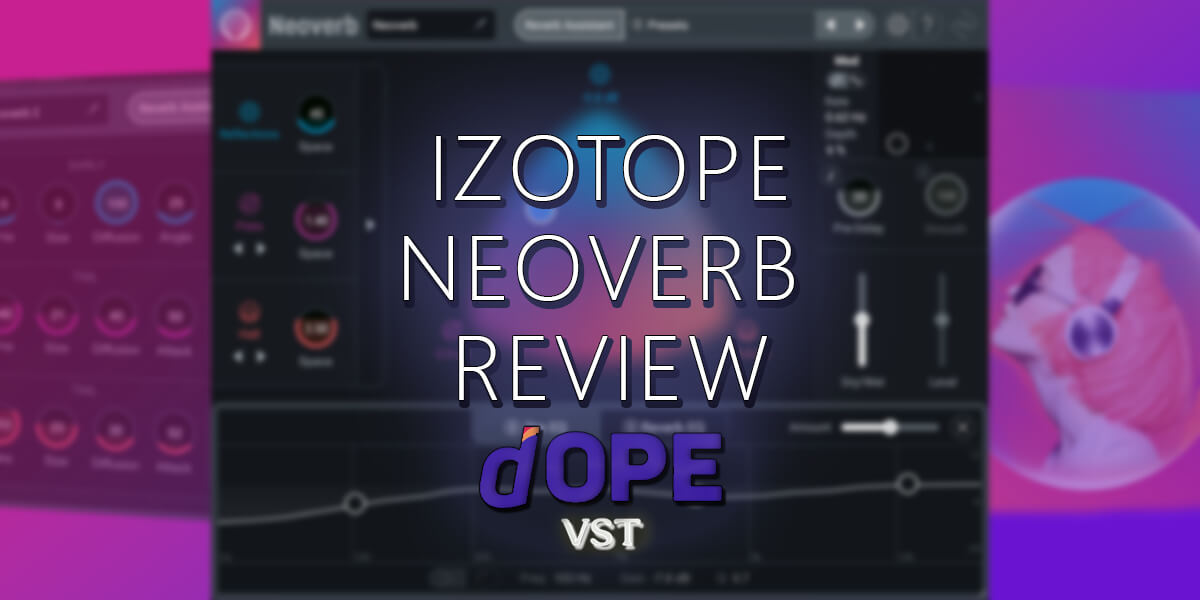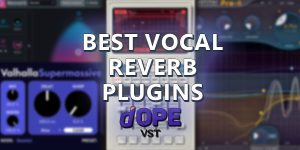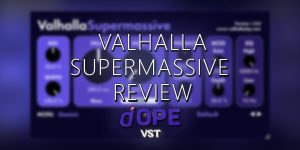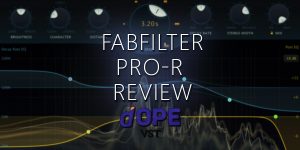The iZotope company offers a reverb that literally listens to your material and helps select a perfect space for your mix. In my opinion, it is a very simple but, at the same time, unique instrument that allows you to achieve excellent results in a matter of minutes.
In my iZotope Neoverb review, I’ll share some insight on this reverb and explain how it functions.
Main controls
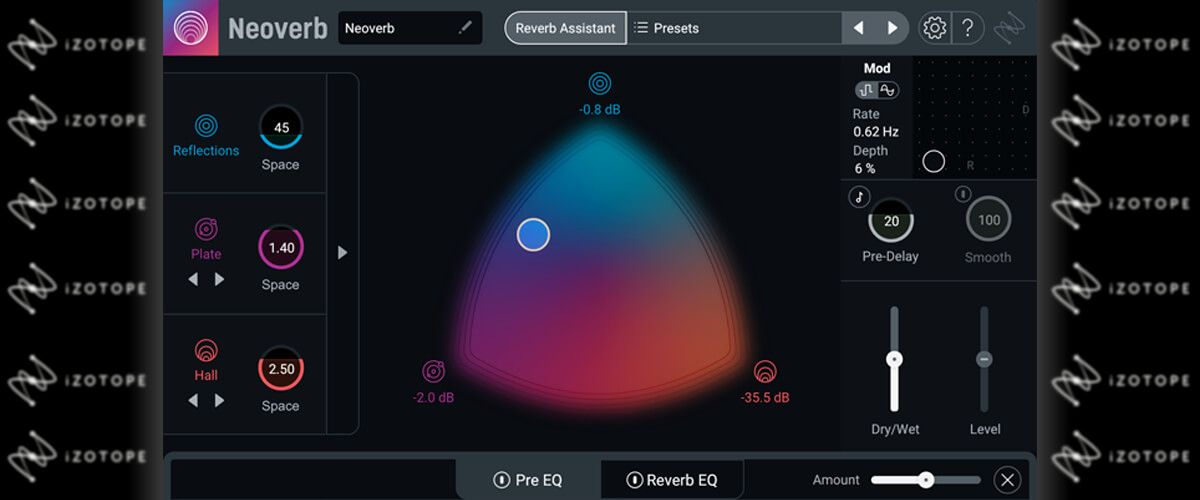
Neoverb includes a plethora of controls for customizing its different reverb sizes. So, let’s take a closer look at them all.
The plugin’s Reverb Assistant is one of the most important components. If you want to fully grasp how it works, I’ll describe the process step by step:
- Play the track to which you want to apply the reverb.
- Choose a reverb style – Realistic gives a space similar to the sound of small rooms, while Dramatic provides a deeper, more flying sound.
- Set the room size – from Extra Small to Extra Large. Then use the Dry/Wet knob to adjust the raw and processed signal ratio.
- Set the brightness of the reverb to your liking in the Tone menu. Four ” colors ” are available: Clean, Dark, Bright, and Airy.
- Once you have set all the parameters, click the Next button. The Assistant analyzes and processes the signal; Auto Cut cleans up the signal at the reverb’s input (Pre EQ curve). Further, Unmask compares the dry & processed signal and, based on that, generates a curve in the Post EQ, de-masking the most important signal frequencies.
Thanks to iZotope Neoverb’s flexible interface, you can quickly tweak the sound. In the center of the interface, there is a colored triangle. At its top, you’ll find early reflections and very short tails, essential for creating the smallest spaces. In the lower-left corner, there are medium spaces, such as Room, Plate, and Medium Chamber. Larger spaces – Hall and Large Chamber – are in the lower right corner.
A huge advantage of this plugin is that you can mix different room types by moving the slider inside the triangle. This lets you discover the right sound for your instrument by ear and fine-tune it with the controls.
Almost all functions for each reverb type are the same; however, there are some differences, which we’ll see below.
Space synchronously manages the Time and Size parameters, enabling you to specify the space size. While Size regulates the dimensions of the space, Time adjusts the tail timing for medium and large spaces or the number of tails for Reflections. Early reflections (as well as the Pre-Delay parameter) can be set to be bound to the note duration.
Diffusion is responsible for the density of reflections – the tighter they are, the better reverb is heard in the mix.
Attack determines how distinct the signal in the tail is – the lower the value, the clearer the signal. So if you want to blur the sound or make a background, just raise this value.
Angle (for Reflection) set at 0 leaves only early reflections. If you increase it, you’ll mix in very short tails, making the sound denser and more sparkling.
Tone controls the position of the crossovers to determine where you want the reverb to be more noticeable.
Other features I love in iZotope Neoverb are Mod (modulation effect), Pre EQ, Reverb EQ, and the Smooth parameter. The modulation effect allows blending in reflections for more audible clarity in the mix. At the same time, the pre-EQ module provides equalization of the incoming signal before it passes through the reverb. The Reverb EQ module helps shape the reverb tone by controlling the frequency response of each output channel separately. Finally, the Smooth parameter adjusts the degree of “smoothness” of reflections (by default 100%), helping you achieve the right reverberation level for your mix.
Producers and engineers can easily craft clear and professional mixes with these powerful tools.
How does It sound in the mix?
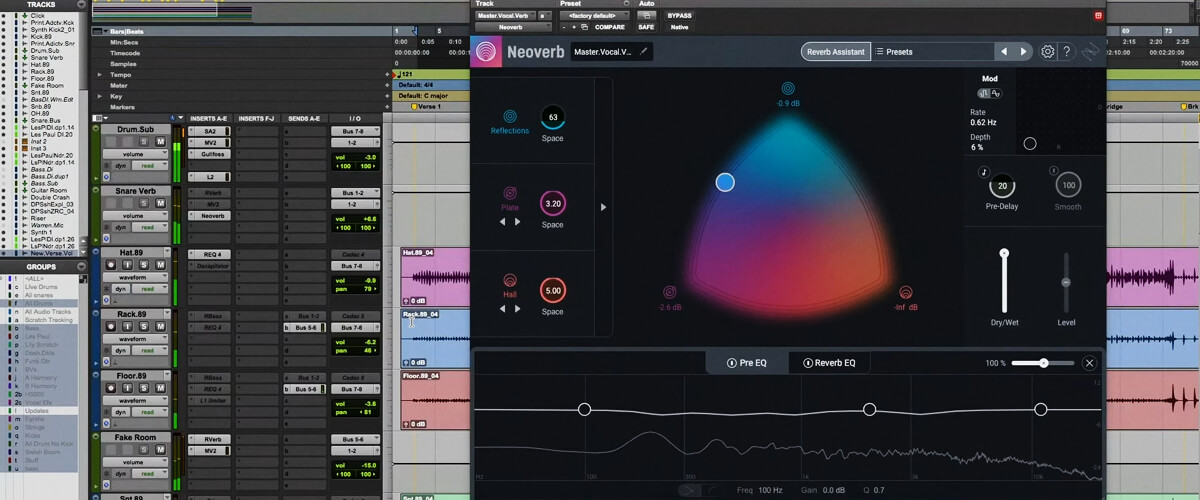
The plugin is amazing for tonal instruments, especially vocals. Thanks to 3 room algorithms, which can work simultaneously, you’ll get really unique and fascinating audio, although the Plate algorithm sound seemed a bit artificial to me.
When it comes to percussion, I enjoy the reverb sound on snare and toms, particularly the one with long tails. Unfortunately, I didn’t manage to put a live drum kit in the room nicely with iZotope Neoverb. However, I found an interesting application for this VST in tracks with electronic drums.
Tech specifications
- Formats: AAX, AU, VST, VST3.
- Platform: Mac, Windows.
- System requirements – Mac: macOS 10.13 or later, only 64 bit.
- System requirements – Windows: Microsoft Windows 10 or later, only 64 bit.

